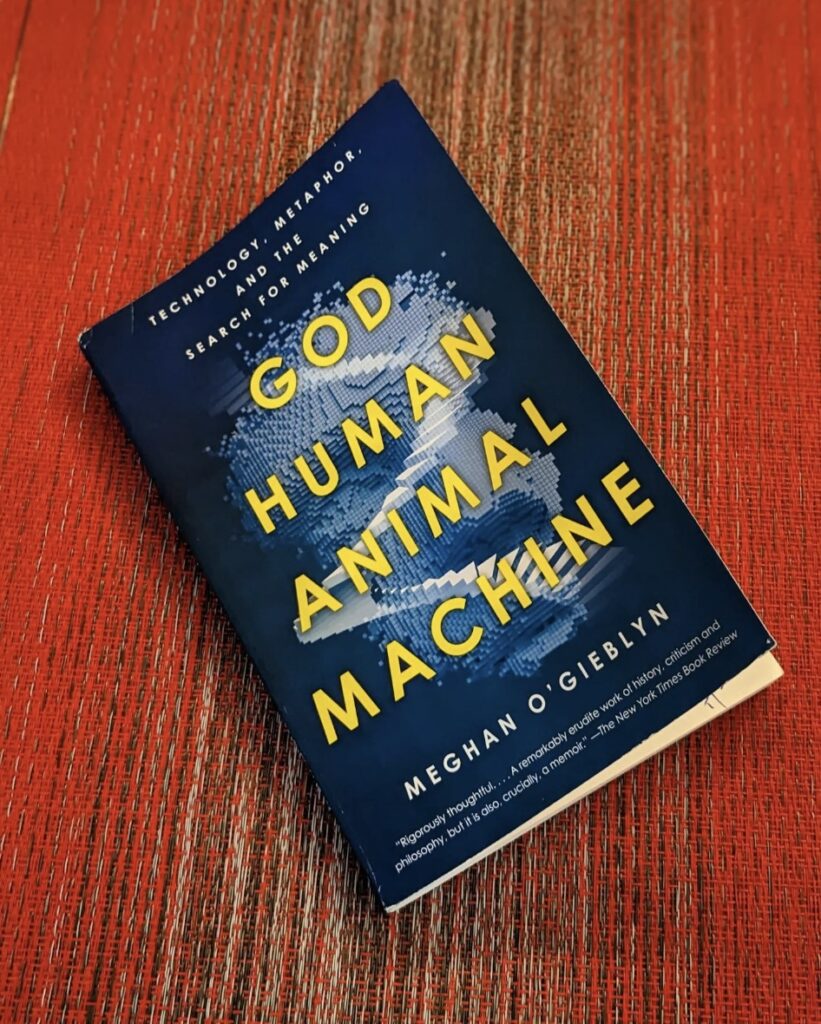Meghan O’Gieblyn
It is difficult to slot God, Human, Animal, Machine: Technology, Metaphor, and the Search for Meaning. Meghan O’Gieblyn sets us off on a thought-provoking exploration of the intersection of faith, technology, and the human experience, and traverses many interesting paths to understand what makes us human, and our search for meaning. Descartes started us on the path to the Enlightenment by ‘separating’ the material world and our ‘soul. From then, we took pride in using scientific temperament and technology to systematically solve nature’s puzzles. And now, when the same toolkit has created machines whose learning and thinking models are increasingly ‘black boxes’, there is fear, uncertainty and probably a bit of ego.
Through chapters that are at once seamless and disparate, she navigates philosophy, technology, and theology and our different ways of understanding God, ourselves, and the world we are creating through technology. The metaphors of our time are built around technology, and AI and tech are raising questions that have for long been asked by philosophers – free will, immortality, the relationship between mind and body. Science by definition requires an objective perspective, and consciousness can only be felt, and measured inside. I can never know what it feels like to be another person. While there are many hypotheses, this is an area which science has been unable to really crack.
In ‘Pattern’ it is interesting to see the many parallels between the Bible and the belief systems of technologists, despite many of the latter being atheists. Transcendence through the Singularity and trans-humanism, just as through the Book of Revelation, the resurrection and rapture, for instance. I really liked Kurzweil’s idea of consciousness as a pattern of information that persists over time. Essentially like a stream that rushes past the rocks in its path. The actual molecules of water change, but the stream remains the ‘same’. In a letter to the author, he shares a wonderful insight that “the difference between so-called atheists and people who believe in ‘God’ is a matter of the choice of metaphor, and we could not get through our lives without having to choose metaphors for transcendent questions.” From (divine) clockmakers to computers.
In the chapter ‘Network’, the idea of emergence is discussed in the context of consciousness, and so is the work of many scientists to recreate that – experimenting with robots to see if they evolve complex behaviour from simple rules. It hasn’t really worked thus far, but I did wonder about the amount of time evolution took to ‘produce’ us.
In ‘Paradox’, there is mention of the parallels between quantum mechanics and eastern mysticism, and the idea of us being in a simulation, and/or a multiverse. It is interesting to note that all paths require a reasonable dose of faith! There is a very intriguing part that uses video games to illustrate how the first-person view makes it look like a world that is always complete as things appear when you move. But were they around when the player was not looking? Does the world “only render that which is being observed”?
‘Metonymy’ moves into materialism (science and its ability to reduce everything to causal mechanisms), dualism (mind-body), panpsychism (all things have a mind-like quality) and finally idealism (the physical world is wholly constituted by consciousness). The mind serving as a microcosm of the world’s macroscopic consciousness reminded me of Aham Brahmasmi. Towards the end of this chapter, she quotes Hannah Arendt, who wrote about scientists who believed that computers can do what a human brain cannot comprehend.
That paves the way for ‘Algorithm’, which begins with Chris Anderson’s 2008 view that data deluge has made our scientific method obsolete. It has now gotten to a state where we will accept the algorithm’s perspective probably more than our own mind’s! But as Nick Bostrom has pointed out, there is no reason for a super intelligence to share our values including benevolent concern for others. The algorithm does not necessarily worry about downstream consequences or collateral damage. And yet, even as algorithms are plagued by errors and the biases we have fed it, ‘dataism’, as Yuval Noah Harari states, is the new ideology. That if we have enough data, we can know everything, thereby increasing surveillance and tracking.
The end of this chapter has a chilling, and yet fascinating observation – “What we are abdicating, in the end, is our duty to create meaning from our empirical observations — to define for ourselves what constitutes justice, and morality, and quality of life — a task we forfeit each time we forget that meaning is an implicitly human category that cannot be reduced to quantification. To forget this truth is to use our tools to thwart our own interests, to build machines in our image that do nothing but dehumanize us.”
In ‘Virality’, the final chapter, she discusses how in the digital domain, quantitative measures of success like clicks and likes have overtaken the virtue or validity of the content. There is also the funny (and yet quite true) part of how, when we treat Trump as an algorithm which has mastered social media, it all makes sense!
God Human Animal Machine is intensely thought-provoking, and O’Gieblyn manages to balance curiosity and a healthy skepticism, distilling thoughts from various streams and thinkers, to provide a coherent narrative that fuels more thinking. For all of this, the book is also deeply personal and extremely accessible. Highly recommended.


Leave a Reply